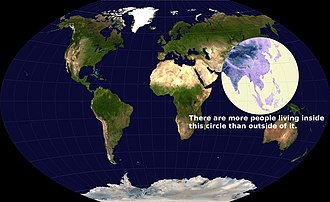Social:Valeriepieris circle

A Valeriepieris circle[1][2][3] is a figure drawn on the Earth's surface such that the majority of the human population lives within its interior. The concept was originally popularized by a map posted on Reddit in 2013, made by a Texas ESL teacher named Ken Myers, whose username on the site gave the figure its name.[4] Myers's original circle covers only about 6.7% of the Earth's total surface area, with a radius of around 4,000 kilometers (2,500 mi), centered in the South China Sea.[1] The map became a popular meme, and was featured in numerous internet media outlets.[5][6][7] Myers's original map uses the Winkel tripel projection, which means that his circle, not having been adjusted to the projection, does not correspond to a circle on the surface of a sphere.[8][9]

In 2015, Singaporean professor Danny Quah—with the aid of an intern named Ken Teoh—verified Myers's original claim, as well as presenting a new, considerably smaller circle centered on the township of Mong Khet in Myanmar, with a radius of 3,300 kilometers (2,050 mi).[1] In fact, Quah claimed this circle to be the smallest one possible, having been produced from more rigorous calculations and updated data, as well as being a proper circle on the Earth's surface.
In 2022, Myers's original circle was again tested by Riaz Shah, a professor at Hult International Business School. Shah used recently published data from the United Nations' World Population Prospects to estimate that 4.2 billion people lived inside the circle as of 2022, out of a total human population of 8 billion.[10]
References
- ↑ Jump up to: 1.0 1.1 1.2 The world’s tightest cluster of people , Danny Quah, London School of Economics and Political Science
- ↑ More Than Half the World's Population Lives Inside This Circle , Condé Nast Traveler
- ↑ A Small Circle in Asia Contains More Than Half the World's Population , HowStuffWorks - Science
- ↑ After seeing a recent post about the population of Indonesia, this occurred to me , Reddit
- ↑ The Majority of the World’s Population Lives in This Circle , Visual Capitalist
- ↑ 40 Maps That Explain the World , The Washington Post
- ↑ Everybody Lives in Asia , Slate
- ↑ More than half of the world's population lives inside this circle , io9
- ↑ If More Than Half the Population of the World Lives in This Circle, Asia is the Future of Startups , Tech in Asia
- ↑ Shah, Riaz (2022-11-10). "Half the world's population lives inside this circle" (in en). https://medium.com/@riazshah/half-the-worlds-population-lives-inside-this-circle-6a076fbaf828.
 |

